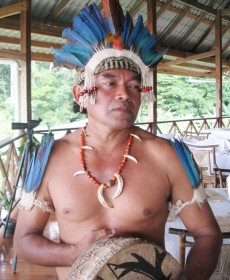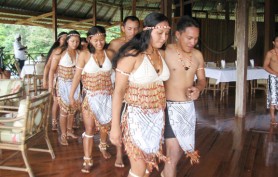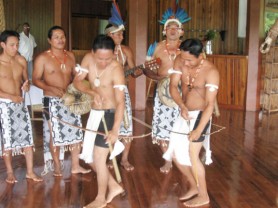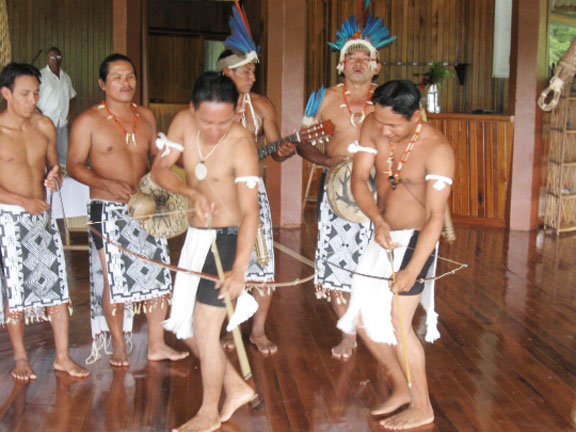Recognising that there has been a loss of various forms of Amerindian culture in their community, the Suruma Makushi Culture Band aspires to use its cultural performances as a means of reigniting interest and involvement in this dying way of life.

“We use the band to try to hold on to culture for as long as possible. When children look at us they must be inspired,” said Glendon Allicock, leader of the group which is based in Surama, Region Nine. “Our culture is rapidly declining and nobody is saying anything to stop this,” he said in dismay.
The home of the Makushi Culture Band is a community which is located 18 miles north of Annai, which has approximately 280 residents who regard tourism as their main export product. While over the years at heritage celebrations, there have been groups who have performed, this band is the most recognised of its kind and works diligently to better its craft.
Seven years ago, the group was formally established and based on the quality of its performances has been invited to perform at many events including Carifesta X, various Amerindian heritage celebrations and functions. In April, the group was invited by the state of Roraima, Brazil and had the opportunity to perform before President Luiz Inacio Lula da Silva.

Allicock said that they have to constantly keep up with the invitations to perform and once time avails they would perform where ever they can.
The idea of a formal band was conceived several years ago when the group participated at the Regional Heritage Celebrations where it won the ‘Best Band Award.’ Allicock said that after winning that accolade, the realisation dawned that they could do anything and there has been no slowing down since then.
Over the years, membership has grown and is divided along two groups: juniors (5-14 years) and adults. Because of time constraints imposed by school for the junior members, the adults play the major role in the band’s activities. There are two drummers, a triangle player and a guitarist and ten dancers.

“I am very passionate about my culture,” the vocalist/song writer says, “it is to be cherished and improved upon – rather it’s disappearing and leaving us.” He recalls his grandmother, whom he said had a wealth of knowledge, told him many stories about the past.
He said that while in school, he and his classmates could not speak their native language since English was the official language and they would be spanked if they did not speak English. As a result, many of his friends do not know to speak their language but he is thankful that he knows his.
He believes that if Amerindians cannot speak their language, then they can chant or sing and be able to hold on to a very important element of their identity; noting that everything which was done by his ancestors was done via chant which was accompanied by a dance.

“I can recall my granny doing the farming dance in her language — three steps in forward and three steps back,” he recounts. Explaining, he said that indigenous people have a deep connection to spirits of their environment namely the earth, sun and moon. Further, as children of the forest, Amerindians had to know how to get in touch with the spirits which controlled various aspects of their life.
It is Makushi belief that planting should be done during the full moon and homage has to be paid to the spirit which protects the crops. “If you plant something with a sad heart and mind then you will not get a good yield but if you chant happily, you will have bountiful fruits,” Allicock explained.
Another dance, the ‘Hunt Dance’ was done at five in the morning before the hunters headed out to the forest as a show of respect for the life to be taken. As the hunters circled the fire, their chants were directed to the master of the animals who they informed of their intention to hunt and whom they asked not to cast any spell on them. This ritual, which uses the mind and heart, goes on until he is satisfied. When the hunter gets a certain feeling, it is believed that the spirit of the animals has responded and it is now safe to go. If the man fails to return by a specified time, the ladies have a chant for the male’s safe return home.
The Parashara dance is a traditional ceremonial dance reserved for special occasions. The dance brings everyone – elders and youths – together and acts as an ice-breaker so that their spirits can be free to interact with each other.
The Cotton Dance illustrates the qualities needed by men and women before they become married. For the woman, she should know to spin cotton, weave hammocks, and make farine and others; while the male has to know to make craft, hunt and fish before he takes a wife.
Smiling Allicock says, “We can go on and on about dances but these are the main ones.”
Turning his attention back to music, he says that traditional songs bring unity and memories between communities. Thus, the songs which have been produced by his group have their origins in stories which have been passed on. He opined that the time had come for Amerindians to listen to their own music and realise that they can reproduce this in various languages once they are organised and willing.
A project funded by German NGO Eerepami/Weltwarts has a community volunteer who helps them to compile their recordings and this has enabled the group to produce a seven-track CD which is available for sale at the Walter Roth Museum and at Iwokrama. The second volume will be released at the Regional Heritage Celebrations in Region Nine later this month.
Performing has given the group opportunities to redefine its craft and to improve. Members are aware that every bit of advice which has been given to them is a form of improvement for them. “We are improving, not 100% and we hope that our work will be continued by the youths,” the band leader said.
“Youths nowadays are not passionate about culture but if they get a glimpse they might get involved,” he adds. Allicock maintains that culture is integral to the identity of Amerindians and it is the main means whereby they can be identified as unique. He aims to continue to passionately work for the transmission of his culture through his band’s music and hopes that his work will be carried on by the younger generation.

